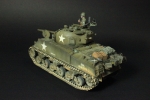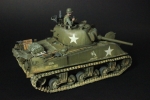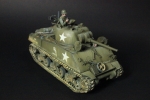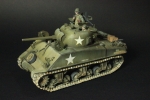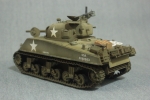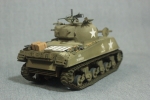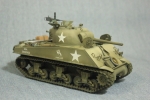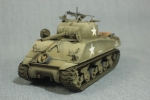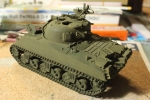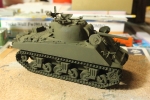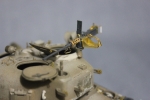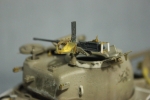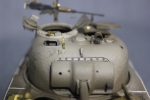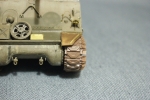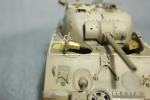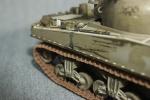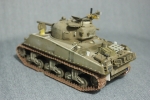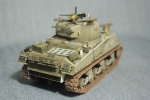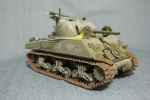1⁄35M4A3
The Sherman tank is my favorite WW2 tank and among all the variants M4A3 is my top-of-the-list. This M4A3 model is based on the famous Tamiya 1/35th scale kit (Kit No. 35250/3300) and was initially built in 2010. Although the Tamiya kit depicts the upper hull, lower hull, and turret very accurately, it lacks much of the necessary details, even by 2010 standards. I used a number of spare parts from Dragon (periscope guard, handles, commander and loader hatches, etc.), and Academy (M2 machine gun) to add much of the missing details. The model was then painted using Vallejo’s olive drab, followed by basic color modulation, and put on the shelf to collect dust for several years. It was done in a “fast-food” way and I was very disappointed to see it 8 years later.
A good model does not deserve to be done in such a careless way, so in 2018 I decided to refurbish it with my best effort. The stowage was first wedged off with a model knife and paint was then removed using various chemicals (water, ethanol, propanol) and sand paper.
The rebuild started with raising the upper hull by 2mm. Spacers made from styrene sheet were place under the engine deck, and the gap between transmission cover and driving sprocket. This will give more space between the return rollers and the upper hull, giving the suspension a more realistic look compared to Sherman photos. Secondly, the recessed weld beads (a major defect of the Tamiya kit) on the upper hull were corrected by placing styrene tube in the recessed area and shaping to form weld beads using a model knife. Thirdly, weld beads that hold the side skirt were added using styrene tubes. These weld beads, according to historical photos, should be placed between every two holes of the skirt bracket.
Photo etched (PE) parts are from Eduard (part No. 35454). All periscope guards were replaced by PE parts after the plastic parts from the initial build were removed. The PE parts added a plethora of details to the M4A3 and made the model very interesting. Among all the details the ones on the M2 .50 Cal. are the most exciting ones. They give the old Academy M2 a new life!
The T48 tracks are from Modelkasten and building them was the most time consuming part of the refurbish. However, Modelkasten’s Sherman tracks are superb in terms of accuracy, richness of detail and the actual “workability” therefore they are worth the time and effort. This is also why I ordered a few sets of this product when they are “in stock”. The track kit does not come with a jig therefore I recommend to build a jig first as it will save a lot of time when lining up the track pads.
After checking carefully with a flashlight to locate any defect in surface finish, gaps, molding marks and etc., the base coat was applied using Tamiya acrylic paint. Following that another base coat of Vallejo paint was applied. Highlights were added to the top parts of the turret, frontal armor, side armor, and gun shield using base coat and white mixed at 1:1 ratio. All the small details (bolts, periscope guards, handles, tools, stowage .etc) were hand-painted using Vallejo paints. A semi-gloss clear coat was then applied. I chose the decals for a M4A3 named “Caballero” that belongs to the 69th Tank Battalion, 6th Armored Division and was knocked out on January 1945. Close inspection of historical photo showed that the left side “horseman” painting was removed at or before the moment of knock out. This finding greatly satisfied me because the decal was partially degraded due to inappropriate storage and one of the two horseman decals was fragmented. It was also found that one of the road-wheels (the fifth on the left side) was replaced with a stamped one, instead of disc road-wheel. Although disappointing, I decided to keep all the disc road-wheels until I can find further evidence to show that “Caballero” indeed used a mix of road-wheels.
Weathering is a mix of oil paints for filter, wash and fading, acrylics for dry-brush, scratches, chips, rain marks, fuel stain and dust, and pigments for dirt and mud. A second layer of clear coat was applied to protect the above weathering effect. Some of the highlight and shadow was diminished by the weathering procedure so they were re-established using oil paint. For example, white mixed with a tiny amount of green, and black oil paint was applied to the top and bottom parts of the front armor respectively, and was then blended using a soft brush. At places with dark shadow, such as the bottom part of the turret and top of the turret where the opened hatch covers, dark blue was used to reinforce the shadow. I kept all the weathering, and chipping effect light to represent a vehicle that was barely used (and hope this can cover the mismatch of the road-wheel to historical photo). But I did painted a lot of chips and rust on the 155mm ammo rack on the engine deck to give a visual contrast.
A Hobby shop owner in Beijing told me that “humans are the spirit of a scale model”. Since then I have added at least one figure to each model. 4 of the 5 crews (assistant gunner is absent) were added to this model. They are a good mix of Tamiya’s driver and co-driver, Tamiya’s loader, and Dragon’s commander with wrist modified to better fit to the vehicle. All figures were hand-painted using Vallejo acrylic paint.
This M4A3 is now back to the shelf again.
A good model does not deserve to be done in such a careless way, so in 2018 I decided to refurbish it with my best effort. The stowage was first wedged off with a model knife and paint was then removed using various chemicals (water, ethanol, propanol) and sand paper.
The rebuild started with raising the upper hull by 2mm. Spacers made from styrene sheet were place under the engine deck, and the gap between transmission cover and driving sprocket. This will give more space between the return rollers and the upper hull, giving the suspension a more realistic look compared to Sherman photos. Secondly, the recessed weld beads (a major defect of the Tamiya kit) on the upper hull were corrected by placing styrene tube in the recessed area and shaping to form weld beads using a model knife. Thirdly, weld beads that hold the side skirt were added using styrene tubes. These weld beads, according to historical photos, should be placed between every two holes of the skirt bracket.
Photo etched (PE) parts are from Eduard (part No. 35454). All periscope guards were replaced by PE parts after the plastic parts from the initial build were removed. The PE parts added a plethora of details to the M4A3 and made the model very interesting. Among all the details the ones on the M2 .50 Cal. are the most exciting ones. They give the old Academy M2 a new life!
The T48 tracks are from Modelkasten and building them was the most time consuming part of the refurbish. However, Modelkasten’s Sherman tracks are superb in terms of accuracy, richness of detail and the actual “workability” therefore they are worth the time and effort. This is also why I ordered a few sets of this product when they are “in stock”. The track kit does not come with a jig therefore I recommend to build a jig first as it will save a lot of time when lining up the track pads.
After checking carefully with a flashlight to locate any defect in surface finish, gaps, molding marks and etc., the base coat was applied using Tamiya acrylic paint. Following that another base coat of Vallejo paint was applied. Highlights were added to the top parts of the turret, frontal armor, side armor, and gun shield using base coat and white mixed at 1:1 ratio. All the small details (bolts, periscope guards, handles, tools, stowage .etc) were hand-painted using Vallejo paints. A semi-gloss clear coat was then applied. I chose the decals for a M4A3 named “Caballero” that belongs to the 69th Tank Battalion, 6th Armored Division and was knocked out on January 1945. Close inspection of historical photo showed that the left side “horseman” painting was removed at or before the moment of knock out. This finding greatly satisfied me because the decal was partially degraded due to inappropriate storage and one of the two horseman decals was fragmented. It was also found that one of the road-wheels (the fifth on the left side) was replaced with a stamped one, instead of disc road-wheel. Although disappointing, I decided to keep all the disc road-wheels until I can find further evidence to show that “Caballero” indeed used a mix of road-wheels.
Weathering is a mix of oil paints for filter, wash and fading, acrylics for dry-brush, scratches, chips, rain marks, fuel stain and dust, and pigments for dirt and mud. A second layer of clear coat was applied to protect the above weathering effect. Some of the highlight and shadow was diminished by the weathering procedure so they were re-established using oil paint. For example, white mixed with a tiny amount of green, and black oil paint was applied to the top and bottom parts of the front armor respectively, and was then blended using a soft brush. At places with dark shadow, such as the bottom part of the turret and top of the turret where the opened hatch covers, dark blue was used to reinforce the shadow. I kept all the weathering, and chipping effect light to represent a vehicle that was barely used (and hope this can cover the mismatch of the road-wheel to historical photo). But I did painted a lot of chips and rust on the 155mm ammo rack on the engine deck to give a visual contrast.
A Hobby shop owner in Beijing told me that “humans are the spirit of a scale model”. Since then I have added at least one figure to each model. 4 of the 5 crews (assistant gunner is absent) were added to this model. They are a good mix of Tamiya’s driver and co-driver, Tamiya’s loader, and Dragon’s commander with wrist modified to better fit to the vehicle. All figures were hand-painted using Vallejo acrylic paint.
This M4A3 is now back to the shelf again.
Copyright ©2021 by Lu Yuan. Images and/or videos also by copyright holder unless otherwise noted. The views and opinions expressed herein are solely the views and opinions of the authors and/or contributors to this Web site and do not necessarily represent the views and/or opinions of Armorama, KitMaker Network, or Silver Star Enterrpises. All rights reserved. Originally published on: 2019-02-02 00:00:00. Unique Reads: 5509





